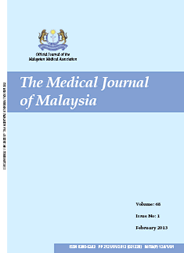MJM, Vol 70 Supplement 1 September 2015
Subtypes of disability among community dwelling
older adults in Malaysia
*Julius Centre University of Malaya, Department of Social and Preventive Medicine, University of Malaya, Kuala Lumpur, Malaysia, **Ministry of Health, Malaysia, ***Negeri Sembilan State Health Office, Negeri Sembilan, ****Kuala Pilah District Health Office, Negeri Sembilan
ABSTRACT
Introduction: Disability is a dynamic process and individual’s progression from impairments to disability is bidirectional and can change at different stages. This study aims to characterize the subtypes of disability and to determine whether the incidence of these disability subtypes differ according to age, sex, or health related variables.
Methods: Prospective cohort study of 875 community dwelling older adults in Kuala Pilah, Negeri Sembilan, who were 60 years and above and initially non-disabled in 6 essential activities of daily living (ADL). Disability was assessed using Katz’s ADL scale. Face to face interview at baseline and 12 months follow-up was conducted and during the interval, disability was assessed via three monthly telephone interviews.
Results: During the 12-month interval, incident of disability was 14.1%. The most common subtypes were transient disability (4.5%); defined as a single disability episode lasting only 1 month, followed by short term (4.4%); defined as single disability episode lasting 2 to 5 months, and long-term (4.2%); defined as one or more disability episodes, with at least one lasting 6 or more months. There were no sex differences in the incidence rates for any of the subtypes. The significant differences of the disability subtypes incidence were observed in older adults with advanced age (p <0.001), cognitive impairment (p = 0.022), low physical activity (p = 0.003) and low social support (p = 0.002).
Conclusion: By identifying modifiable risk factors such as low social support and low physical activity, the current study provides important findings for the healthcare providers in order to recognise older adults at risk of disability, so that preventive interventions can be suitably targeted.
Keywords: disability subtypes, community dwelling older adults, incidence, risk factors, Malaysia
